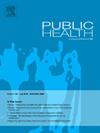Factors associated with acceptance of preventive treatment among college students with latent tuberculosis infection in Shandong, China
IF 3.9
3区 医学
Q1 PUBLIC, ENVIRONMENTAL & OCCUPATIONAL HEALTH
引用次数: 0
Abstract
Objectives
In China, little is known about factors associated with acceptance of tuberculosis (TB) preventive treatment (TPT) among college students. This study investigates the factors associated with the acceptance of TPT for latent tuberculosis infection (LTBI) among college students.
Study design
This was a cross-sectional study.
Methods
The study included 874 college students with LTBI. Multivariable logistic regression was used to explore the factors associated with the acceptance of TPT among college students with LTBI.
Results
LTBI college students who were aware of TB core knowledge [odds ratio (OR) = 2.10, 95 % confidence interval (CI): 1.37–3.20)], had not been screened with a PPD test before enrollment in the college (OR = 1.76, 95 % CI: 1.21–2.57), did not think that TPT frequency was excessive (OR = 1.96, 95 % CI: 1.30–2.96), and those who believed that TPT would not impact their study or life (OR = 1.54, 95 % CI: 1.01–2.35) were more likely to accept TPT. However, LTBI college students who had no family members or classmates with a history of TB (OR = 0.29, 95 % CI: 0.17–0.50), who were not informed by medical staff that they belonged to a high-risk group for TB (OR = 0.48, 95 % CI: 0.30–0.75), and whose family members did not support their participation in TPT (OR = 0.10, 95 % CI: 0.06–0.17) were more likely to refuse TPT.
Conclusions
Acceptance of TPT among college students with LTBI has been associated with factors such as awareness of core TB knowledge, perceptions of the TPT process, family support, and risk communication by medical staff prior to treatment. Colleges can pay attention to these factors in their practice of LTBI management.
山东潜伏性肺结核感染大学生接受预防治疗的相关因素
目的在中国,对大学生接受结核病预防治疗(TPT)的相关因素知之甚少。本研究旨在探讨影响大学生接受结核潜伏感染(LTBI) TPT的相关因素。研究设计:这是一项横断面研究。方法选取874名LTBI大学生为研究对象。采用多变量logistic回归分析,探讨LTBI大学生对TPT接受程度的影响因素。ResultsLTBI大学生意识到结核病核心知识(比值比(或)= 2.10,95%可信区间(CI): 1.37 - -3.20)],没有筛选与产后抑郁症在大学入学前测试(OR = 1.76, 95% CI: 1.21—-2.57),不认为TPT频率过多(OR = 1.96, 95% CI: 1.30—-2.96),和那些相信TPT不会影响他们学习或生活(OR = 1.54, 95% CI: 1.01—-2.35)更有可能接受课程。然而,没有家庭成员或同学有结核病史的LTBI大学生(or = 0.29, 95% CI: 0.17-0.50),没有医务人员告知他们属于结核病高危人群(or = 0.48, 95% CI: 0.30-0.75),以及家庭成员不支持他们参加TPT (or = 0.10, 95% CI: 0.06-0.17)更有可能拒绝TPT。结论LTBI大学生对TPT的接受程度与结核病核心知识的认知、TPT过程的认知、家庭支持和医务人员治疗前的风险沟通等因素有关。高校在LTBI管理实践中应注意这些因素。
本文章由计算机程序翻译,如有差异,请以英文原文为准。
求助全文
约1分钟内获得全文
求助全文
来源期刊

Public Health
医学-公共卫生、环境卫生与职业卫生
CiteScore
7.60
自引率
0.00%
发文量
280
审稿时长
37 days
期刊介绍:
Public Health is an international, multidisciplinary peer-reviewed journal. It publishes original papers, reviews and short reports on all aspects of the science, philosophy, and practice of public health.
 求助内容:
求助内容: 应助结果提醒方式:
应助结果提醒方式:


